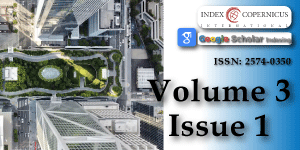Study the effect of transient vibration on multi-storey building structure according to equivalent spring-mass system performed by Ansys
Main Article Content
Abstract
The carried work has based on transient vibration response of multiple degrees of freedom (MDOF) system. By this work study of Time–history analysis and prediction of the displacement for excitation has done. For the MDOF system, we have taken the four-storey building to done transient vibration. We establish the equivalent spring-mass system. Transient analysis has done for both Undamped and Damped of the forced system of multiple degrees of freedom (MDOF) system. In the case of the Damped system, we have done three stages of damping, i.e., (1) Underdamped system, (2) Critically damped system, (3) Overdamped system. The time-history graph obtained for two different time stages i.e. 0.001 sec & 0.01 sec with initial time 0.000001 sec. The natural frequency has determined by both theoretical calculation and ANSYS. The whole study of transient vibration makes it possible to predict the damping values that oppose any kind of sudden impact or force vibration, such as blasts, earthquakes and tsunamis. The ANSYS is the modelling and simulation software is used to perform the transient vibration response. The Mode Superposition method is used by ANSYS to calculate the structure response.
Article Details
Copyright (c) 2025 Sen D, et al.

This work is licensed under a Creative Commons Attribution 4.0 International License.
Chopra AK. Multi-Degree-of-Freedom Systems. Dynamics of Structures: Theory and Applications to Earthquake Engineering. Pearson Education, Inc., Prentice Hall, One Lake Street, Upper Saddle River, NJ. 1995; 347-392. Ref.: http://tinyurl.com/y4d8htph
Damodarasamy SR, Kavitha S. Basics of Structural Dynamics and Aseismic Design. Multiple Degrees of Freedom Systems. PHE Learning Private Limited, New Delhi. 2005; 158-165. Ref.: http://tinyurl.com/y5d73yqq
Agarwal P, Shrikhande M. Earthquake Resistant Design of Structures. Dynamics of Multi-Degree-of-Freedom Systems. Prentice Hall of India, New Delhi. 2015; 156-187.
Paz M. Structural Dynamics-Theory and Computation. Response to General Dynamic Loading. CBS Publishers and Distributors, New Delhi. 1996; 101-140. Ref.: http://tinyurl.com/y5uv6nf3
Wright JR, Cooper JE. Introduction to Aircraft Aeroelasticity and Loads. Vibration of Multiple Degree of Freedom Systems’, John Wiley & Sons, Ltd. 2015; 27-47. Ref.: http://tinyurl.com/y3ly69tc
Rao SS. Mechanical Vibrations. Multidegree-of-Freedom Systems. Pearson Education, Inc., Prentice Hall, 1 Lake Street, Upper Saddle River, NJ. 2004; 553-623. Ref.: http://tinyurl.com/y4c5rrgm
Clough RW, Penzien J. Dynamics of Structures. Multi-Degree-of-Freedom Systems. McGraw-Hill, New York. 1993; 169-179. Ref.: http://tinyurl.com/yyeqshl6
Graham Kelly S. Mechanical Vibrations: Theory and Applications. Modeling of MDOF System. Cengage Learning, First Stamford Place, Stamford, USA. 2012; 459-506. Ref.: http://tinyurl.com/y27t5tjm

